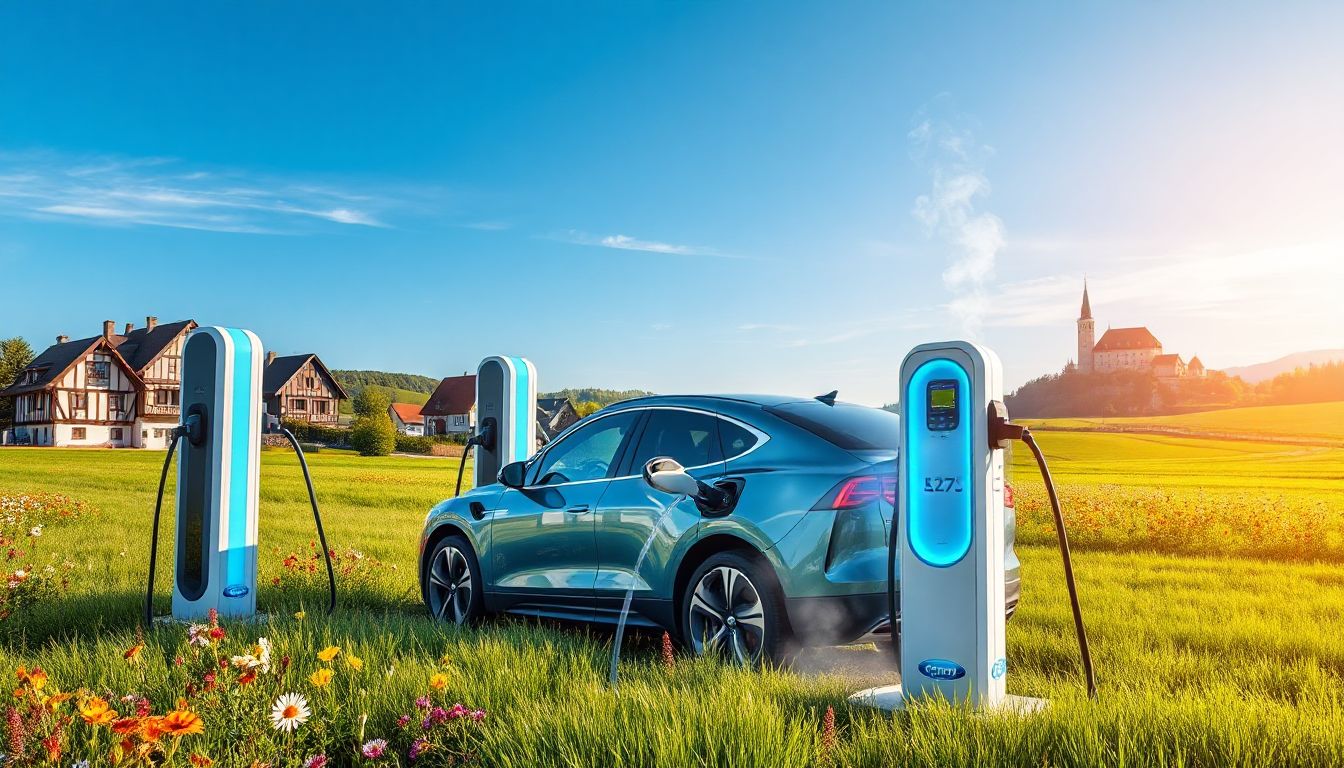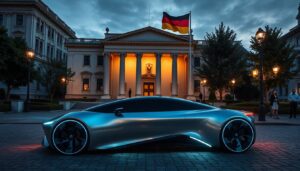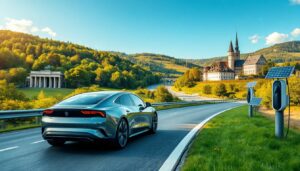Introduction
Germany is racing ahead to embrace electric vehicles (EVs). More people are choosing EVs as fuel prices rise and climate worries grow. This shift is changing how we travel and ideas about clean transportation. German leaders have set clear goals to cut emissions and boost EV usage. Building a strong network of charging stations is key to reaching these goals. Today, Germany is quickly expanding its EV charging infrastructure. By 2030, it aims to have millions of chargers across cities and countryside. This article explores the current scene, future plans, and what’s needed to keep the momentum going.
The Current Landscape of EV Charging Stations in Germany
Overview of Germany’s EV Market and Adoption Rates
Germany’s EV market has seen rapid growth. In 2022, more than 700,000 electric cars were sold, a big jump from previous years. EVs now make up around 15% of new car sales. The government promotes EVs through incentives and stricter emission rules. Many Germans see electric cars as a smart choice for the future. This momentum shows no signs of slowing down as more drivers switch to EVs.
Types of Charging Stations Available
Electric vehicles rely on different kinds of chargers, each suited for specific needs:
- Level 1 chargers: Use a standard household outlet. Slow but good for home use.
- Level 2 chargers: Faster, requiring a special outlet. Perfect for parking garages and commercial spaces.
- DC fast chargers: The quickest option, adding hundreds of miles of range in minutes. Ideal for highway stops and long trips.
Charging stations are found in many places. Public spots are common in cities, while semi-public stations serve shopping centers and workplaces. Private chargers stay at homes and private properties, giving owners easy access.
Geographic Distribution and Infrastructure Density
Most EV chargers cluster in big cities like Berlin, Hamburg, and Munich. These urban areas see the fastest growth due to dense population and better infrastructure. Rural regions still face hurdles. Finding fast Chargers in small towns remains a challenge. The government and private firms are working to fill these gaps, so everyone gets fair access. Urban areas lead the charge, but expanding to rural parts is the next big step.
Planning and Installation of EV Charging Stations in Germany
Regulatory Framework and Permitting Processes
Getting a charging station ready involves navigating complex laws. Local and federal rules set safety standards, electrical codes, and permits. This can slow down the process but is necessary for safety. Some regions offer streamlined permits to support faster rollout. Clear rules help builders avoid hiccups and plan effectively.
Key Stakeholders and Partnerships
Building chargers isn’t a solo effort. It involves government agencies, utility companies, and private businesses. For example, BMW and Siemens recently teamed up on a charging pilot project in Berlin. Such collaborations often bring better technology and funding. Strong partnerships ensure chargers are reliable, accessible, and up to date.
Technical Standards and Compatibility
Standards matter for smooth charging. Most stations follow CCS or CHAdeMO standards, and some serve Tesla owners with unique connectors. Making sure chargers work with all vehicles is essential. Interoperability prevents confusion and allows EV owners to travel freely without worrying about compatibility. Keeping up with future tech means choosing adaptable, upgradeable systems from the start.
Actionable Tips for Stakeholders
- Pick the right location—near highways or busy urban spots.
- Know local rules and get permits early.
- Use proven, standard-compliant equipment.
- Think ahead for future upgrades.
- Partner with reliable tech providers and utility companies.
Funding and Incentives for Charging Infrastructure Development
Government Grants and Subsidies
Germany offers many programs to support EV infrastructure. The NIP program funds innovative projects focusing on clean tech. Local governments also provide grants for charging stations at homes, businesses, and public spaces. These programs often require specific eligibility criteria, so early planning is key. Taking advantage of incentives can lower costs significantly.
Private Investment and Public-Private Partnerships
Many companies see EV charging as a smart investment. Public-private partnerships help share costs and risks. For example, Shell invested heavily in fast chargers across German highways. Private investors benefit through service fees and long-term profits. These projects boost the network fast and keep costs manageable.
Cost-Benefit Analysis and ROI
Installing chargers pays off in many ways. Besides earning revenue, it encourages more EV sales, which benefits everyone. Cities and towns see cleaner air and healthier residents. Through careful planning and smart management, operators can maximize profits and promote sustainability. Investing wisely in charging stations makes sense for both the economy and the environment.
Innovations in EV Charging Technology in Germany
Smart Charging and Vehicle-to-Grid (V2G) Integration
Smart chargers can communicate with grid systems, adjusting power flow based on demand. This helps balance energy use and reduces costs. V2G technology even lets EVs send stored energy back to the grid when needed. Pilot projects in Berlin show how this can help prevent blackouts and lower energy bills for owners.
Ultra-Fast Charging and Battery Technology Advances
Recent advances allow ultra-fast chargers that replenish up to 80% of a car’s battery in under 20 minutes. This cuts charging times dramatically and makes long trips easier. As battery technology improves, cars can hold more energy and charge faster, pushing electric mobility further.
Environmental and Sustainability Initiatives
Many chargers now run on renewable energy, like wind or solar power. Installing solar panels on charger sites or using green energy sources helps cut carbon footprints. Such initiatives make electric driving even cleaner and more sustainable.
Actionable Tips for Implementation
- Incorporate renewable energy sources.
- Use advanced, adaptable chargers.
- Consider future tech like V2G.
- Focus on eco-friendly materials and sustainable construction.
Challenges and Future Outlook for EV Charging in Germany
Current Barriers to Infrastructure Expansion
Germany still faces hurdles. Grid capacity needs upgrades to handle more fast chargers. Costs can be high, and some local rules slow down installations. Overcoming these barriers requires coordinated effort between government, utilities, and industry.
Strategies for Scaling Infrastructure
Using digital tools helps plan better locations. Data analytics identify where chargers are most needed. National efforts aim to connect urban and rural areas smoothly. Digital platforms also make access easy and streamline payments.
Future Trends and Predictions
By 2030, Germany hopes to have millions of EVs and thousands of chargers. Electric cars might dominate new vehicle sales. Technological breakthroughs like wireless charging and autonomous vehicle integration will change how we recharge. These innovations will make EV travel seamless and more convenient.
Expert Insights and Policy Directions
Industry leaders emphasize the importance of fast chargers and smart grids. Policymakers aim to double funding for infrastructure and streamline rules. These steps will help Germany stay on track with climate goals while making EVs accessible and practical.
Conclusion
Germany is steering toward a cleaner, greener future with robust EV charging infrastructure. The country’s fast adoption, innovative tech, and strategic investments fuel this journey. Every charging station built gets us closer to sustainable mobility—safer, cost-effective, and better for the planet. Stakeholders from governments to private firms must continue working together. Together, we can unlock the full potential of electric transportation. Are you ready to be part of this change?




